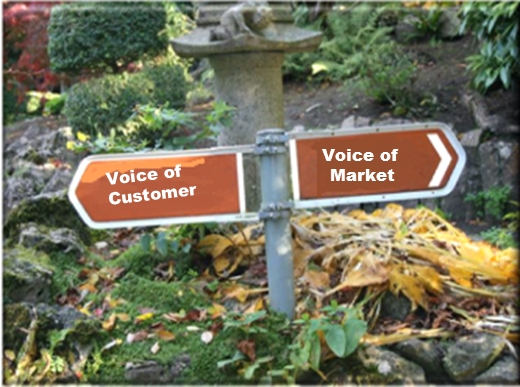NOTE: The following is a guest post by Jennifer Doctor. If you want to submit your own guest post, click here for more information.
During a recent whirlwind #prodmgmttalk discussion on Twitter, there was a side discussion about the differences between Voice of the Market and Voice of the Customer.
What is the difference?
 Voice of the Customer (VoC) is a fairly common term, thrown around when talking about obtaining views that are outside your organization. You have likely used the expression and possibly even implemented VoC research into your organization. VoC is often used to justify new product investment – “the customer wants this” – or when promoting a product – “our customers like this message.”
Voice of the Customer (VoC) is a fairly common term, thrown around when talking about obtaining views that are outside your organization. You have likely used the expression and possibly even implemented VoC research into your organization. VoC is often used to justify new product investment – “the customer wants this” – or when promoting a product – “our customers like this message.”
Voice of the Market (VoM) is different in that it incorporates input from the greater market. The market contains not only your customers, but also those who chose not to buy your solution – those who bought someone else’s product and those who just didn’t make a decision.
VoC is a subset of VoM because your customers are included as a part of the overall market. It’s important to think about VoM (and just VoC), because it’s important to understand why people didn’t buy your product. Focusing only on customers (VoC) will only give you part of the picture.
How to get the differing voices
VoC is the easier voice to obtain. Most organizations incorporate customer visits, warranty cards, user conferences, customer advisory panels or win/loss analysis to gather up comments from customers. And, it is typically pretty easy for you to pull together a list of customers to contact. A happy customer usually will give you the few minutes you seek. (And, an unhappy customer will ALWAYS give you the few minutes you seek.)
But, because VoM takes a look at the much wider prospective or eligible market including non-buyers, lost business and even those unable to buy, it is definitely more work to capture. However, the yield from this research is quite different. It is typically less biased data and can provide more in-depth information on the true motivational behaviors behind the action you are trying to learn. It is common to use a third-party to gather this data, under your direction, to eliminate bias. Of course, you will work with them on goal setting, target identification and questions to ask. And, when you get back the raw data, you can perform your own analysis and make your own conclusions.
But, there are other ways to collect the VoM as well. You could attend a trade show where you expect your target market to attend. Rather than go to sessions, stay in the common areas, listen and chat with those people. You could also call a member of the market and let them know that you will be in town and arrange to meet. Finding VoM candidates takes more work. It is common to start with referrals from your trusted circle of friends, family and advisors and then build out from there. And remember to treat the time like a networking meeting – always asking for a referral with whom you should meet next.
Putting them together
VoC is often used to validate, to justify or rationalize business decisions, both for programs and products. It is used to learn to think like a customer. And, of course, the data gathered is the basis for user personas. More people have questions about how to integrate VoM data into our business. The first point of reference is the business case. This is where you present your idea and justifications for change (entering a new market, new product development, new strategy, etc.) The market voice here is critical to support the idea.
VoM is also the basis for the buyer personas you develop. Buyer personas are representations of the market you are trying to reach – their goals, attitudes and behaviors, You should have questions in your market interviews asking about how decisions are made, the cycle for making the decisions, budget responsibility, etc. All of this matters in trying to understand your buyers and users at a deeper level so that later on, you’ll know exactly how to hit their “hot” buttons.
But, in my opinion, VoM data is best at helping you remember to “keep it real.” If you remember what you heard outside of the walls, by people who haven’t selected your product yet to solve their problem, it is much easier to stay focused. Try this – next time you are debating whether to do a campaign, how to write a presentation, to include a feature, etc, simply say “would my market care?” (Of course, if you have the personas done, this statement becomes easier.)
Looking in from the outside, you need the information from both voices inside your organization. When you know what you are trying to achieve, when you have a plan, you will know when to ask the right ‘who’ about the right ‘what’. Without that plan and understanding, you need to stop talking: no one will buy because no one is listening.
Tweet this: @onpm Voice of the Market vs. Voice of the Customer http://wp.me/pXBON-2v2 Guest post by @jidoctor #prodmktg #prodmgmt
———-
Jennifer Doctor, a strong advocate of ProductCamps, is an independent product marketing and management consultant, working with companies to help them understand their markets, buyers and how to better enable sales teams to deliver results. She maintains her own blog – The OutsideIn View – and can be reached at Jennifer dot doctor at gmail dot com.